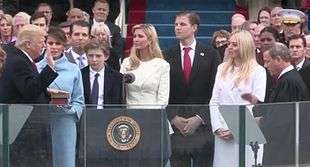Fred Trump
| Frederick Trump | |
|---|---|
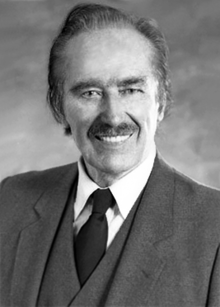 | |
| Born |
Frederick Christ Trump October 11, 1905 New York City, U.S. |
| Died |
June 25, 1999 (aged 93) New Hyde Park, New York, U.S. |
| Resting place | Lutheran All Faiths Cemetery, New York City, U.S. |
| Nationality | American |
| Education | Richmond Hill High School |
| Occupation |
Real estate developer Elizabeth Trump & Son Co. |
| Net worth | US$250–300 million (June 1999) |
| Spouse(s) | |
| Children | |
| Parent(s) |
Frederick Trump Elizabeth Christ Trump |
| Relatives | See Trump family |
Frederick Christ Trump (October 11, 1905 – June 25, 1999) was an American real estate developer, primarily in New York City, and father of Donald Trump, the 45th President of the United States, and Maryanne Trump Barry, a United States Court of Appeals judge.
Fred Trump's father Frederick died when Fred was 12 years old. By 15, in partnership with his mother Elizabeth Christ Trump[1] and non-family investors, Trump had begun a career in home construction and sales. The development company was incorporated as Elizabeth Trump & Son in 1927, and grew to build and manage single-family houses in Queens, barracks and garden apartments for U.S. Navy personnel near major shipyards along the East Coast, and more than 27,000 apartments in New York City.[2][3]
Trump was investigated by a U.S. Senate committee for profiteering in 1954.[4] He made Donald the president of Trump Management Company in 1971,[5] and they were sued by the U.S. Justice Department's Civil Rights Division for violating the Fair Housing Act in 1973.[6]
Early life
.jpg)
Frederick, Sr. had become rich during his exploits in the Klondike Gold Rush,[7] and visited his home of Kallstadt, where he met Elizabeth Christ, the daughter of a former neighbor.[8]:94 Back in New York City, they moved to the German-speaking Morrisania neighborhood of the Bronx, but Elizabeth didn't like it, so they returned to Bavaria. They attempted to immigrate, but could not due to Frederick's having fled mandatory military service years earlier.[9]
They conceived their first son, and returned to New York upon the SS Pennsylvania on July 1, 1905. Frederick Christ Trump was born in the Bronx on October 11, 1905.[10] Trump was one of three children of German Lutheran immigrants Elizabeth (née Christ) and Frederick Trump. He had a younger brother John and an older sister Elizabeth Trump Walters (1904–1961).
Soon after Fred's birth, the family moved to Woodhaven, Queens. When he was 12 years old, his father died during the 1918 flu pandemic.[3] From 1918 to 1923, he attended Richmond Hill High School in Queens.[8]:117
Family trade
Trump became a carpenter and took classes in reading blueprints.[11] Two years after his graduation, he finished his first house, and since he was still under age, his mother formed Elizabeth Trump & Son and officially headed it until he was 21. In 1926, he had already built 20 homes in Queens.[12] By the mid-1930s, in the middle of the Great Depression, he helped pioneer the concept of supermarkets with the Trump Market in Woodhaven, which advertised "Serve Yourself and Save!", becoming an instant hit. After a year, Trump sold it to the King Kullen supermarket chain.[11]
1927 arrest at KKK march
On Memorial Day in 1927, the Ku Klux Klan marched in Queens to protest "Native-born Protestant Americans" being "assaulted by Roman Catholic police of New York City".[13] Fred was one of seven men arrested that day "on a charge of refusing to disperse from a parade when ordered to do so,"[13] as reported in a New York Times article on June 1, 1927. He shared lawyers with the other men, but "it's conceivable that he may have been an innocent bystander, falsely named, or otherwise the victim of mistaken identity during or following a chaotic event."[14] He was "released without charges", but Vice Magazine noted that the KKK had gone through a revival in urban areas after 1915.[15] All seven men arrested were declared to be wearing Klan attire in one source cited in the Vice article, which noted: "While the Long Island Daily Press doesn't mention Fred Trump specifically ... the article refers to all of the arrestees as 'berobed marchers.' If Fred Trump, or another one of the attendees, wasn't dressed in a robe at the time, that may have been a reporting error worth correcting."[15] When asked about the issue in September 2015 by The New York Times, Donald Trump, then a candidate for presidency of the United States, denied that his father had been arrested or that he had been in the KKK.[16]
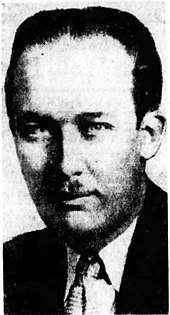
Personal life
Fred's future wife Mary Anne MacLeod emigrated from Glasgow, Scotland on the RMS Transylvania in November 1929.[17] She stated her occupation as "domestic" or "maid" on ship manifests and the 1930 census.[17] She obtained a "re-entry permit" to the U.S.—only granted to "lawful, permanent residents" intending to stay and gain citizenship[18][19]—and returned to Scotland on the SS Cameronia on September 12, 1934.[20]
Trump, a Lutheran, married Mary, a Presbyterian, in January 1936 at the Madison Avenue Presbyterian Church with George Arthur Buttrick officiating.[21] A wedding reception with 25 guests was held at the Carlyle Hotel in Manhattan. Fred and Mary Trump settled in Jamaica, Queens,[17] and had five children.[22][23] They are or were: Maryanne Trump Barry (born 1937), a federal appeals court judge; Frederick Christ "Freddy" Trump Jr. (1938–1981), an airline pilot with Trans World Airlines;[24] Elizabeth Trump Grau (born 1942), an executive at Chase Manhattan Bank;[25][26] Donald Trump (born 1946), businessman, television personality and 45th President of the United States;[27] and Robert Trump (born 1948), a top executive of his father's property management company.[22] Freddy Trump Jr. predeceased his parents, dying at 42 of complications associated with alcoholism.[24][28]
Although both of his parents were German,[10] for decades after World War II Trump told friends that his family was of Swedish origin. According to his nephew John Walter, "He had a lot of Jewish tenants and it wasn't a good thing to be German in those days."[3]
Career
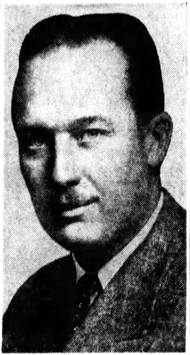
During World War II, Trump built barracks and garden apartments for U.S. Navy personnel near major shipyards along the East Coast, including Chester, Pennsylvania, Newport News, Virginia, and Norfolk, Virginia. After the war he expanded into middle-income housing for the families of returning veterans, building Shore Haven in Bensonhurst in 1949, and Beach Haven near Coney Island in 1950 (a total of 2,700 apartments). In 1963–1964, he built Trump Village, an apartment complex in Coney Island, for $70 million.[11] He built more than 27,000 low-income apartments and row houses in Coney Island, Bensonhurst, Sheepshead Bay, Flatbush, and Brighton Beach in Brooklyn, and Flushing and Jamaica Estates in Queens.[3]
Folk icon Woody Guthrie was a tenant in one of Trump's apartment complexes in Brooklyn in 1950, and criticized him as a landlord.[4] He wrote lyrics accusing him of stirring up racial hate "in the bloodpot of human hearts".[29]
Profiteering investigation
In 1954, Trump was investigated by a U.S. Senate committee for profiteering from public contracts, including overstating his Beach Haven building charges by $3.7 million.[4] In testimony before the Senate Banking Committee in 1954, William F. McKenna, appointed to investigate "scandals" within the FHA, cited Fred C. Trump and his partner William Tomasello as examples of how profits were made by builders using the FHA.[30]:409 McKenna said the two paid $34,200 for a piece of land which they rented to their corporation for $76,960 per year in a 99-year lease, so that if the apartment they built on it ever defaulted, the FHA would owe them $1.924 million. McKenna said that Trump and Tomasello obtained loans for $3.5 million more than the apartments cost.[30]:58 The following month, Trump testified before the Senate Banking Committee that due to rising costs, he would have had to invest more than the 10% of the loan not provided by the FHA, and therefore suffer a loss if he built under those conditions.[30]:414–5
Son becomes president
Fred's son Donald Trump joined Trump Management Company around 1968, and rose to become company president in 1971. Donald Trump claimed to receive a loan from his father in the mid-1970s of $1 million (documented as numerous loans exceeding $14 million).[31] This allowed Donald to enter the real estate business in Manhattan, while his father stuck to Brooklyn and Queens.[32] "It was good for me," Donald later commented. "You know, being the son of somebody, it could have been competition to me. This way, I got Manhattan all to myself."[3]
Civil rights suit

Minority applicants turned away from renting apartments complained to the New York City Commission on Human Rights and the Urban League, leading the League and other groups to send test applicants to Trump-owned complexes in July 1972. They concluded that whites were offered apartments, while blacks were generally steered away. Both advocacy organizations then raised the issue with the Justice Department.[6] In October 1973, the Civil Rights Division of the U.S. Department of Justice (DOJ) filed a civil rights suit against the Trump organization (Fred Trump, chair & Donald Trump, president) for "violating the Fair Housing Act of 1968."[6] In response, Trump attorney Roy Cohn "portrayed the Trumps as the victims and counter-sued" for $100 million by implicating the DOJ for "falsely accusing them of discrimination."[6]
Court records showed that "four superintendents or rental agents confirmed that applications sent to the Trump organization's central office for acceptance or rejection were coded by race."[33] A rental agent said Fred Trump had instructed him "not to rent to blacks" and to "decrease the number of black tenants" "by encouraging them to locate housing elsewhere."[33] A consent decree between the DOJ and the TO was signed on June 10, 1975, with both sides claiming victory—the TO for its perceived ability to continue denying rentals to welfare recipients, and the head of DOJ's housing division for the decree being "one of the most far-reaching ever negotiated."[6][33] It personally and corporately prohibited the Trumps from "discriminating against any person in the ... sale or rental of a dwelling," and "required Trump to advertise vacancies in minority papers, promote minorities to professional jobs, and list vacancies on a preferential basis with the Open Housing Center of the Urban League."[33] Finally, it ordered the Trumps to "thoroughly acquaint themselves personally on a detailed basis with ... the Fair Housing Act of 1968."[6][34]
Wealth and estate
Trump appeared on the initial Forbes 400 list of richest Americans in 1982 with an estimated $200 million fortune shared with his son Donald.[35] In 1976, Trump had set up trust funds of $1 million for each of his five children and three grandchildren ($4.3 million in 2017 dollars), that paid out yearly dividends.[36] By 1993, the siblings' anticipated shares of Trump's estate amounted to $35 million each.[37][36] Upon Trump's death in 1999, his will divided $20 million after taxes among his surviving children.[36][38][39]
In October 2018, The New York Times published an exposé drawing on more than 100,000 pages of tax returns and financial records from Trump's businesses, and interviews with former advisers and employees. The Times concluded that his son Donald "was a millionaire by age 8,"[40] and that he had received $413 million (adjusted for inflation) from Fred's business empire over his lifetime.[41] According to the Times, Trump loaned at least $60 million to his son, who largely failed to reimburse him.[40] The paper also described a number of purportedly fraudulent tax schemes, for example when Trump sold shares in Trump Palace condos to his son well below their purchase price, thus masking what could be considered a hidden donation, and benefiting from a tax write-off.[41] Donald Trump's lawyer denied the allegations of fraud and tax evasion, while the New York tax department stated they would investigate the issue.[42]
Philanthropy
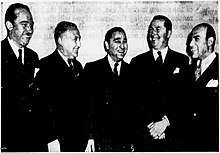
Fred and Mary Trump supported medical charities by donating buildings. After Mary received medical care at the Jamaica Hospital Medical Center, they donated the Trump Pavilion.[3][43][44] Community Mainstreaming Associates of Great Neck, "an organization that provides homes for functionally retarded adults," received a two building complex in Brooklyn in a combined gift to the National Kidney Foundation of New York/New Jersey.[3][43] The Cerebral Palsy Foundation of New York and New Jersey also received a building.[3] In addition, Fred made charitable contributions to the Long Island Jewish Hospital and the Hospital for Special Surgery in Manhattan,[3] and Mary served on the Women's Auxiliary of the Jamaica Day Nursery.[43]
Trump supported Jewish and Israeli causes and institutions, including donating the land for the Beach Haven Jewish Center in Flatbush, New York.[45] He significantly supported Israel Bonds, debt securities that trade at a risk-adjusted spread to U.S. Treasury bonds issued by the Israeli government.[46] The Trumps were active in the Salvation Army, the Boy Scouts of America and the Lighthouse for the Blind.[43] Fred also supported the Kew-Forest School,[3] where his children attended, and he served on the board of directors.[47]
Later years and death
During the 1980s, Fred Trump became friends with future-Prime Minister of Israel Benjamin Netanyahu, who was the Israeli Ambassador to the United Nations in Manhattan.[48]
The Trumps had a happy, affectionate marriage, remaining together until Fred's death.[8] He suffered from Alzheimer's disease for the last six years of his life,[3] and finally fell ill with pneumonia in June 1999. He was admitted to Long Island Jewish Medical Center in New Hyde Park, where he died at age 93 on June 25.[49] Trump's estate was estimated by his family at $250 million to $300 million.[3] His funeral was held at the Marble Collegiate Church[49] and his body is interred at Lutheran All Faiths Cemetery in Middle Village, Queens.[50] His widow, Mary, died the following summer, on August 7, 2000, in New Hyde Park, New York, at age 88.[43]
References
- ↑ "If you think Trump's money comes from his dad, you're only half right". TheBillFold.
- ↑ Blair, Gwenda (2015). The Trumps: Three Generations of Builders and a Presidential Candidate. Simon and Schuster. pp. 121, 156. ISBN 978-1501139369.
- 1 2 3 4 5 6 7 8 9 10 11 12 Rozhon, Tracie (June 26, 1999). "Fred C. Trump, Postwar Master Builder of Housing for Middle Class, Dies at 93". The New York Times. Retrieved January 29, 2017.
- 1 2 3 Moyer, Justin William (January 22, 2016). "The Unbelievable Story of Why Woody Guthrie Hated Donald Trump's Dad". The Washington Post. Retrieved January 29, 2017.
- ↑ Blair, Gwenda (2005). Donald Trump: Master Apprentice. Simon & Schuster. p. 23. ISBN 978-0743275101.
- 1 2 3 4 5 6 Kranish, Michael & O'Harrow Jr., Robert (January 23, 2016). "Inside the Government's Racial Bias Case Against Donald Trump's Company, and How He Fought It". The Washington Post. Retrieved January 29, 2017.
- ↑ "Trump's Großvater war ein Glücksritter aus der Pfalz". Südwestpresse. 9 August 2016. Retrieved August 25, 2018.
- 1 2 3 Blair, Gwenda (2000). The Trumps: Three generations that built an empire (1st Touchstone ed.). New York: Simon & Schuster. ISBN 978-0743210799.
- ↑ "Letter Donald Trump's Grandfather Wrote Pleading to Stay in Germany Surfaces". The Wall Street Journal. November 21, 2016. Retrieved August 25, 2018.
- 1 2 Blair, The Trumps, p. 110.
- 1 2 3 Snyder, Gerald S. (July 26, 1964). "Millionaire Calls Work His Hobby". The Bridgeport Post: 65. Retrieved January 29, 2017 – via Newspapers.com.
- ↑ Blair, The Trumps, pp. 120–122.
- 1 2 Bump, Philip (February 29, 2016). "The Fix: In 1927, Donald Trump's Father Was Arrested After a Klan Riot in Queens". The Washington Post. Retrieved January 29, 2017.
- ↑ Blum, Matt (September 9, 2015). "1927 news report: Donald Trump's dad arrested in KKK brawl with cops". Boing Boing. Retrieved January 28, 2018.
- 1 2 Pearl, Mike (March 10, 2016). "All the Evidence We Could Find About Fred Trump's Alleged Involvement with the KKK". Vice. The Vice Guide to the 2016 Election. Retrieved January 29, 2017.
- ↑ Horowitz, Jason (September 22, 2015). "First Draft: In Interview, Donald Trump Denies Report of Father's Arrest in 1927". The New York Times. Retrieved January 29, 2017.
- 1 2 3 Pilon, Mary (June 24, 2016). "Donald Trump's Immigrant Mother". The New Yorker. Retrieved February 12, 2017.
- ↑ Hannah, Martin (May 21, 2016). "The Mysterious Mary Trump: The Full Untold Story of How a Young Scotswoman Escaped to New York and Raised a US Presidential Candidate". The National (Scotland). Retrieved October 4, 2018.
- ↑ Hannah, Martin (May 21, 2016). "An Inconvenient Truth? Donald Trump's Scottish Mother Was a Low-Earning Migrant". The National (Scotland). Retrieved October 4, 2018.
- ↑ "Mary Anne Macleod Trump Biography; Mother of Donald Trump". BiographyTree. September 30, 2016. Retrieved August 20, 2018.
- ↑ Hannan, Martin (May 20, 2016). "An inconvenient truth? Donald Trump's Scottish mother was a low-earning migrant". The National. Retrieved November 19, 2016.
- 1 2 Chabba, Seerat (November 15, 2016). "Who Are Donald Trump's Siblings? What You Need To Know About Maryanne, Freddy, Elizabeth And Robert Trump". International Business Times. Retrieved January 29, 2017 – via IBTimes.com.
- ↑ Powell, Kimberly (March 2, 2016). "Donald Trump's German and Scottish Family Tree". About.com. Retrieved January 29, 2017.
- 1 2 Horowitz, Jason (January 2, 2016). "For Donald Trump, Lessons From a Brother's Suffering". The New York Times. Retrieved January 29, 2017.
- ↑ "Meet the Trumps: The family tree of Donald Trump". MSN News. May 8, 2018. Retrieved May 28, 2018.
- ↑ Gavin, Michael (June 23, 2017). "Trump sister sells oceanfront Westhampton Beach home for $3.8M". Newsday. Retrieved May 28, 2018.
- ↑ Flegenheimer, Matt & Barbaro, Michael (November 9, 2016). "Donald Trump Is Elected President in Stunning Repudiation of the Establishment". The New York Times. Retrieved January 30, 2017.
- ↑ McAfee, Tierney (October 8, 2015). "Donald Trump Opens Up About His Brother's Death from Alcoholism: It Had a 'Profound Impact on My Life'". People. Retrieved January 29, 2017.
- ↑ Kaplan, Thomas (January 25, 2016). "Woody Guthrie Wrote of His Contempt for His Landlord, Donald Trump's Father". The New York Times. Retrieved January 29, 2017.
- 1 2 3 "Hearings Before the Committee on Banking and Currency" (PDF). The Washington Post. United States Senate: Eighty-Third Congress. July 20, 1954. Retrieved August 19, 2018.
- ↑ Berzon, Alexandra & Rubin, Richard (September 23, 2016). "Trump's Father Helped GOP Candidate With Numerous Loans". The Wall Street Journal. Retrieved January 29, 2017.
- ↑ Glum, Julia (September 26, 2016). "How Much Money Did Trump Get From His Dad? The Small Loan Controversy Explained". International Business Times. Retrieved January 29, 2017 – via IBTimes.com.
- 1 2 3 4 Barrett, Wayne (January 15, 1979). "Like Father, Like Son: Anatomy of a Young Power Broker". The Village Voice. Retrieved January 29, 2017. The original 1979 article is reprinted and appended to the 2015 article by Barrett and Campbell.
- ↑ United States of America vs. Fred C. Trump and Trump Management, Inc. (East District of New York Court October 15, 1973). Text
- ↑ Wang, Jennifer (March 24, 2016). "The Ups And Downs Of Donald Trump: Three Decades On And Off The Forbes 400". Forbes. Retrieved June 9, 2018.
- 1 2 3 Kessler, Glenn (March 3, 2016). "Trump's false claim he built his empire with a 'small loan' from his father". The Washington Post.
- ↑ O'Brien, Timothy L. (October 23, 2005). "What's He Really Worth?". The New York Times. Retrieved February 25, 2016.
- ↑ Rozhon, Tracy (June 26, 1999). "Fred C. Trump, Postwar Master Builder of Housing for Middle Class, Dies at 93". The New York Times. Retrieved August 19, 2015.
- ↑ Horowitz, Jason (January 2, 2016). "For Donald Trump, Lessons From a Brother's Suffering". The New York Times.
Then came the unveiling of Fred Sr.'s will, which Donald had helped draft. It divided the bulk of the inheritance, at least $20 million, among his children and their descendants, 'other than my son Fred C. Trump Jr.'
- 1 2 Barstow, David; Craig, Susanne; Buettner, Russ (October 2, 2018). "11 Takeaways From The Times's Investigation Into Trump's Wealth". The New York Times. Retrieved October 3, 2018.
- 1 2 Barstow, David; Craig, Susanne; Buettner, Russ (October 2, 2018). "Trump Engaged in Suspect Tax Schemes as He Reaped Riches From His Father". The New York Times. Retrieved October 2, 2018.
- ↑ Campbell, Jon; Spector, Joseph (October 3, 2018). "New York could levy hefty penalties if Trump tax fraud is proven". USA Today. Retrieved October 5, 2018.
- 1 2 3 4 5 NYT Staff (August 9, 2000). "Mary MacLeod Trump Philanthropist, 88". The New York Times. Retrieved January 30, 2017.
- ↑ Mary's obituary refers to her as being "the mainstay of the Women's Auxiliary of Jamaica Hospital." See NYT Staff, The New York Times, August 9, 2000.
- ↑ TJP Staff (November 21, 2016). "Trump Family Donated Bigly to Jewish, Israeli Causes". The Jewish Press. Brooklyn, NY. JNi.Media. Retrieved January 30, 2017.
- ↑ Haaretz Staff (March 25, 2016). "The Swedish Whopper: Donald Trump's Long-standing Struggle With the Truth" (print and online). Haaretz. Retrieved January 30, 2017 – via Haaretz.com.
- ↑ Tuccille, Jerome (1985). Trump: The Saga of America's Most Powerful Real Estate Baron. Beard Books. p. 38. ISBN 9781587982231. Retrieved February 18, 2017.
- ↑ Sherman, Gabriel (June 1, 2016). "Trump Is Considering a Pre-Convention Visit to Israel". New York [magazine]. Retrieved January 29, 2017 – via NYMag.com.
- 1 2 Mosconi, Angela (June 26, 1999). "Fred Trump, Dad of Donald, Dies at 93". New York Post. Retrieved January 29, 2017.
- ↑ Scovell, Nell (October 11, 2016). "A Visit to Trump's Graveyard". Esquire. Retrieved January 20, 2017.
External links
- Fred Trump at Find a Grave
- Fredrick Trump Jr. at geni.com (registration required)
.jpg)

